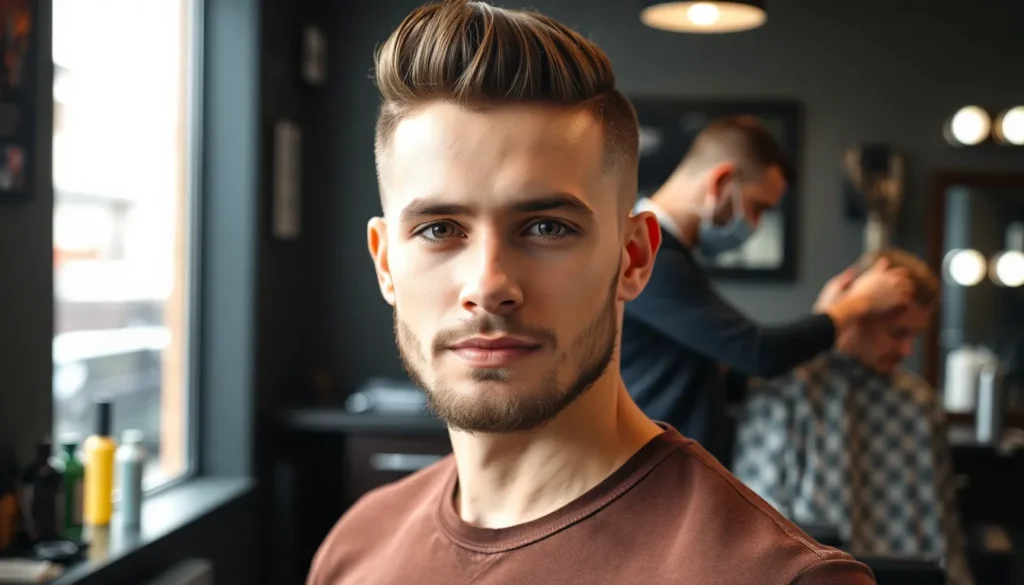Men’s fade haircuts have become the cornerstone of modern barbering and for good reason. These versatile styles seamlessly blend hair from long to short creating a clean polished look that works for virtually every face shape and lifestyle. Whether you’re heading to the boardroom or hitting the gym a well-executed fade delivers that sharp confident appearance every man wants.
We’ve seen fade haircuts evolve from classic military cuts to contemporary masterpieces that showcase a barber’s technical skill. The beauty of fades lies in their adaptability – you can pair them with textured tops sleek sides or bold designs to match your personal style. From subtle low fades to dramatic high fades there’s a variation that’ll transform your look instantly.
The best part? Fade haircuts aren’t just trendy – they’re practical too. They require minimal styling grow out gracefully and keep you looking fresh for weeks. Let’s jump into everything you need to know about choosing and maintaining the perfect fade for your lifestyle.
Understanding the Basics of Men’s Fade Haircuts
We’ll explore the fundamental elements that make fade haircuts unique and examine the professional techniques behind their execution.
What Makes a Fade Different From Other Cuts
Gradual length transitions distinguish fade haircuts from traditional men’s styles that maintain uniform lengths throughout. We see how barbers create seamless blends between different hair lengths, starting longer at the top and gradually shortening toward the neckline and sides.
Precise clipper work forms the foundation of every fade, requiring multiple guard sizes to achieve smooth progressions. Traditional haircuts typically use one or two clipper settings, while fades incorporate three to five different lengths for optimal blending.
Strategic sectioning techniques allow barbers to work methodically from the longest sections downward. We observe how professionals divide the hair into horizontal zones, ensuring each layer connects flawlessly with the next for that signature seamless appearance.
Blending methods separate amateur attempts from professional results through careful guard overlap and proper angle positioning. Expert barbers understand how to eliminate harsh lines by using rocking motions and consistent pressure throughout each pass.
Essential Tools Barbers Use for Perfect Fades
Professional clippers serve as the primary instrument for creating clean fade foundations, with adjustable blades ranging from size 000 to 8. We recommend high quality models like Andis Masters or Wahl Magic Clips that maintain consistent power and blade sharpness.
Multiple clipper guards enable precise length control throughout different fade zones, typically including sizes 0.5, 1, 1.5, 2, 3, and 4. Quality barbers maintain complete guard sets to achieve smooth transitions without jumping between drastically different lengths.
Trimmer detailing tools perfect the hairline and remove stray hairs around the ears and neckline for polished finishing touches. We see professionals using cordless trimmers with zero gap blades for maximum precision in tight areas.
Texturizing shears help blend any remaining harsh lines that clippers might leave, particularly in longer fade variations. Expert barbers use point cutting techniques with these specialized scissors to create natural looking texture where different lengths meet.
Spray bottles keep hair damp during the cutting process, ensuring consistent cutting conditions and helping barbers see their progress clearly. We notice how moisture management prevents hair from flying around and maintains optimal visibility throughout the fade creation process.
Classic High Fade Cuts That Never Go Out of Style
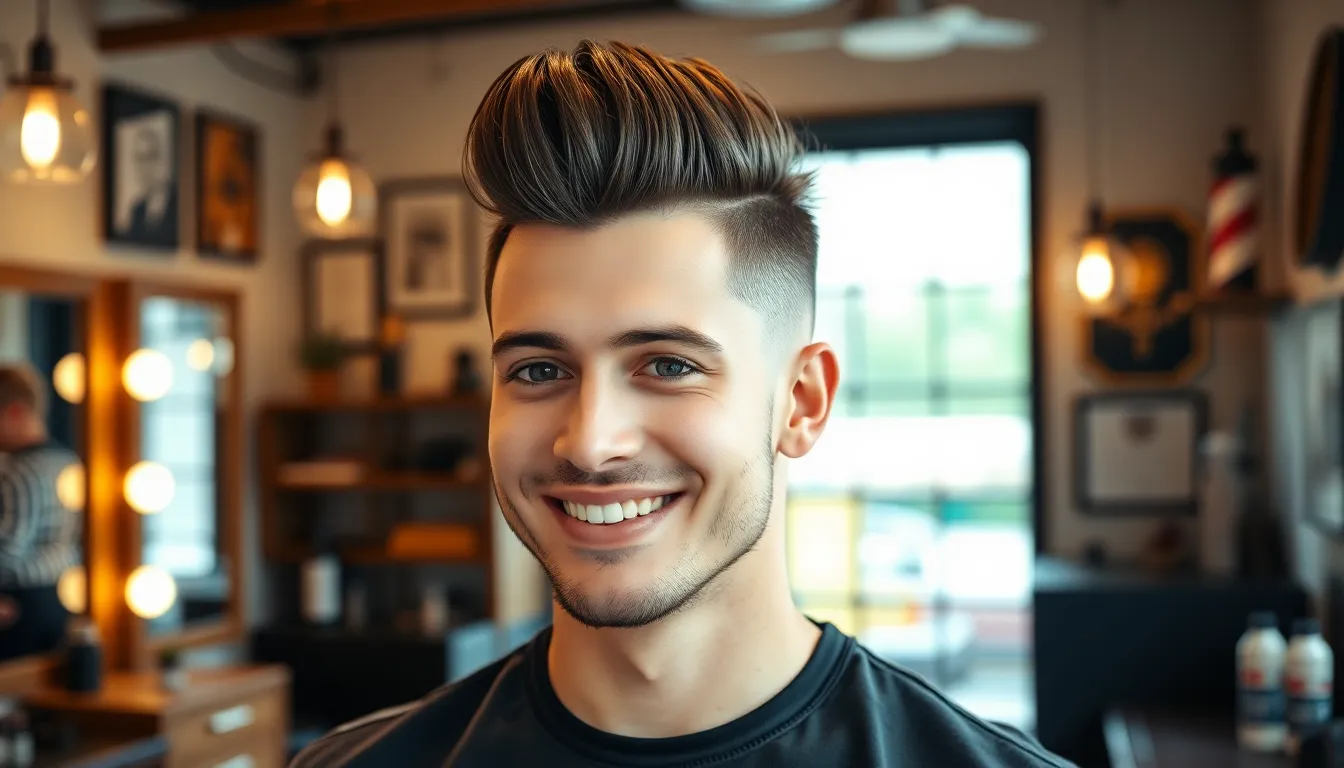
These timeless high fade variations remain barbershop staples because they deliver sophisticated results that work across generations. We’ve seen these cuts maintain their popularity through decades of changing trends.
The Traditional High Fade with Pompadour
Traditional high fade pompadours create an elegant contrast between short sides and voluminous top sections. We recommend this style for men seeking a distinguished look that works in professional settings. The fade starts approximately two inches above the ears, creating dramatic tapering that emphasizes the pompadour’s height and texture.
Styling this combination requires pomade or strong hold gel to achieve the signature swept back volume. We suggest using a blow dryer with a round brush during the styling process to maximize lift and shape. The pompadour section typically measures 4-6 inches in length, allowing for versatility in styling height and direction.
Maintenance involves trimming the fade every 2-3 weeks to preserve the sharp contrast. We find this style particularly flattering for oval and square face shapes, as the vertical emphasis balances facial proportions effectively.
Military Inspired High Fade Variations
Military high fades emphasize precision and clean lines that reflect disciplined grooming standards. We see these cuts featuring extremely short sides with fade lines positioned high on the head, often starting at the temple area. The contrast between the fade and top creates a sharp, authoritative appearance.
Regulation cuts maintain approximately 1-2 inches of length on top, styled forward or slightly to the side. We appreciate how these variations require minimal daily styling while maintaining a polished appearance throughout the day. The fade typically uses a #0 or #1 guard at the bottom, gradually blending to longer lengths.
High and tight variations represent the most dramatic military inspired option, featuring fades that extend nearly to the crown. We recommend these cuts for men who prefer ultra low maintenance styling routines. The military precision requires expert blending techniques to achieve the seamless transitions that define these classic styles.
Modern Low Fade Styles for Professional Settings

Professional environments demand sophisticated grooming choices that balance contemporary style with workplace appropriateness. Low fade variations offer the perfect solution for modern men seeking polished looks without compromising professional standards.
Subtle Low Fade with Side Part
Classic side part styling transforms into a refined contemporary look when paired with a subtle low fade. This combination creates clean lines around the ears while maintaining substantial length on top for versatile styling options.
Barbers achieve this professional style by using a #3 guard at the baseline, gradually transitioning to longer lengths around the temple area. The side part adds structure and sophistication, making this cut ideal for corporate environments, client meetings, and formal occasions.
Styling this cut requires minimal effort with just a small amount of pomade or styling cream worked through damp hair. The side part should be created using a fine tooth comb while the hair is slightly wet for maximum hold and definition.
Face shapes benefit differently from this style, with oval and rectangular faces seeing the most flattering results. The side part’s horizontal line helps balance longer face shapes while the subtle fade maintains proportional harmony.
Daily maintenance involves basic grooming habits like regular washing with quality shampoo and occasional touch ups every 3-4 weeks. The low fade’s conservative nature means it grows out gracefully without looking unprofessional between appointments.
Textured Low Fade for Business Casual Looks
Textured styling adds modern appeal to traditional low fade cuts while remaining appropriate for business casual environments. This approach incorporates natural movement and dimension through strategic cutting techniques and styling methods.
Professional barbers create texture using point cutting and slide cutting techniques on the longer top section. The low fade typically starts with a #2 guard, blending seamlessly into textured lengths that range from 2-4 inches on top.
Styling products play a crucial role in achieving the desired textured finish without appearing too casual or messy. Matte finish styling pastes and sea salt sprays provide hold while maintaining a natural, touchable texture that’s perfect for open office environments.
This versatile style works well for various professional settings including creative industries, consulting firms, and tech companies where business casual dress codes are common. The textured element adds personality while the low fade maintains professional boundaries.
Maintenance schedules should include regular trims every 4-5 weeks to maintain the textured shape and prevent the fade from losing its clean appearance. The textured top requires daily styling but offers flexibility for different looks throughout the workweek.
Mid Fade Haircuts That Balance Style and Versatility

Mid fade haircuts strike the perfect balance between dramatic high fades and subtle low fades, making them incredibly versatile for various lifestyles and preferences.
The Popular Mid Fade with Quiff
Mid fade with quiff combinations dominate modern men’s styling choices because they offer contemporary sophistication with manageable maintenance requirements. We recommend this style for men who want a bold yet professional appearance that transitions seamlessly from office meetings to evening events.
Achieving the perfect mid fade quiff requires exact techniques:
- Start with proper sectioning by creating a horizontal guide line approximately two inches above the ear
- Use clipper guards ranging from size 1 at the fade line to size 3 at the transition point
- Build volume in the quiff by cutting the top section to 3-4 inches in length
- Create texture through point cutting techniques that add movement and body
Styling this combination involves strategic product application:
- Apply volumizing mousse to damp hair for foundation lift
- Use a round brush while blow drying to create the quiff’s signature height
- Finish with medium hold pomade to maintain shape without stiffness
- Brush the quiff backward and slightly to one side for optimal positioning
We’ve observed that this style works exceptionally well for men with thick to medium hair density, as the natural volume supports the quiff structure. The mid fade provides clean sides that won’t compete with the top’s dramatic styling, creating visual balance that flatters most face shapes.
Slicked Back Mid Fade for Formal Occasions
Slicked back mid fade haircuts deliver unmatched elegance for formal events, business presentations, and special occasions where sophisticated grooming makes a lasting impression. This refined combination offers the clean precision of a mid fade with the timeless appeal of slicked back styling.
Professional execution requires attention to exact details:
- Begin the fade at the temple area, approximately 1.5 inches above the ear
- Create smooth transitions using clipper over comb techniques for seamless blending
- Maintain top length between 4-5 inches to ensure proper slicking capability
- Shape the hairline with precision trimming for a polished finish
Styling techniques for formal occasions include:
- Prep with quality shampoo to remove any product buildup that might interfere with sleek styling
- Apply styling cream to towel dried hair for smooth texture and manageability
- Use a fine tooth comb to distribute product evenly from roots to ends
- Finish with high shine pomade for that classic, formal appearance
We suggest scheduling touch up appointments every 3-4 weeks to maintain the mid fade’s sharp lines, especially when wearing this style for important business functions. The slicked back element requires daily styling but offers incredible versatility, allowing you to adjust the sleekness level based on the occasion’s formality.
Maintenance schedule for optimal results:
| Timeframe | Maintenance Task | Purpose |
|---|---|---|
| Daily | Product application and combing | Maintains sleek appearance |
| Weekly | Deep conditioning treatment | Keeps hair healthy and manageable |
| Bi-weekly | Trim split ends | Prevents rough texture |
| Monthly | Professional fade touch up | Preserves clean lines |
This styling approach complements formal attire perfectly, from business suits to black tie events, making it our top recommendation for men who frequently attend professional or social gatherings requiring elevated grooming standards.
Skin Fade Techniques That Create Sharp, Clean Lines
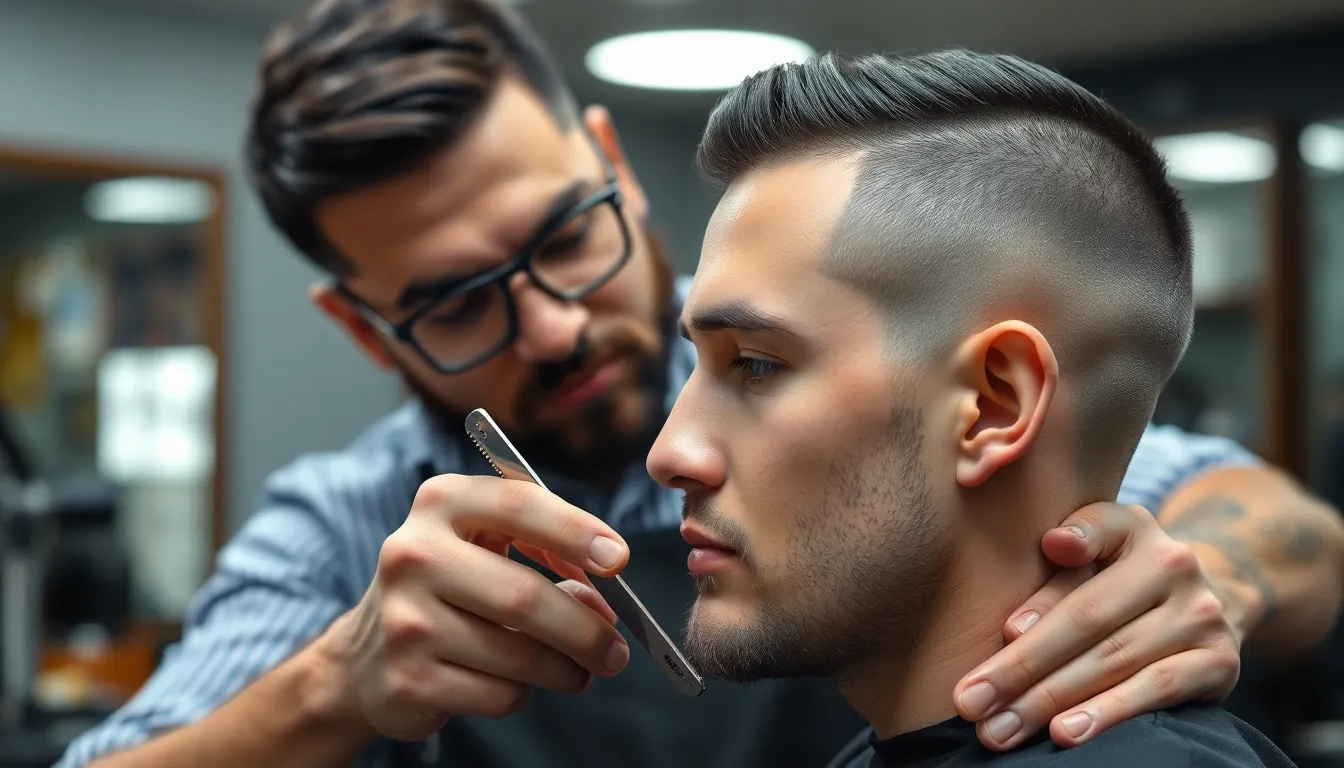
Mastering skin fade techniques requires precision and attention to detail that separates professional results from amateur attempts. We’ll explore the most effective methods for achieving razor sharp transitions that eliminate all visible lines.
Bald Fade Execution and Maintenance
Starting with the proper foundation sets the tone for a flawless bald fade. We begin by using a size 0 guard to establish the initial fade line, working systematically from the natural hairline upward. Professional barbers create these dramatic transitions by gradually removing hair length in precise sections.
Building the fade requires multiple clipper passes with different guard sizes. We use guards ranging from 0 to 3, blending each section seamlessly into the next. The key lies in overlapping each pass by approximately 50% to avoid creating harsh demarcation lines.
Detailing work with trimmer attachments perfects the skin level finish. We carefully outline the hairline and remove any remaining stubble using foil shavers or detail trimmers. This final step creates the ultra clean appearance that defines a true bald fade.
Maintenance schedules for bald fades differ significantly from other fade styles. We recommend touch ups every 7 to 10 days to maintain the sharp contrast between skin and hair. Regular maintenance prevents the fade from appearing grown out or unkempt.
Daily care routines help extend the life of bald fade cuts. We suggest using alcohol free aftershave balms on the faded areas to prevent irritation and ingrown hairs. Moisturizing the scalp daily keeps the skin healthy and enhances the overall appearance.
Razor Fade for Ultra-Precise Results
Professional straight razors deliver the most precise fade transitions available. We use these traditional tools to create seamless blends that clippers alone cannot achieve. The razor technique requires extensive training and steady hands to execute safely.
Sectioning becomes critical when working with razor fade methods. We divide the hair into horizontal sections no wider than one inch, working methodically from bottom to top. Each section receives individual attention to ensure consistent length transitions.
Proper razor angles determine the quality of the final result. We maintain a 30 degree angle between the razor and scalp while using smooth, controlled strokes. The blade direction follows the natural hair growth pattern to minimize irritation and achieve optimal results.
Steam preparation softens hair cuticles for smoother razor work. We apply hot towels or steam to the area before beginning the fade process. This preparation reduces tugging and allows for cleaner cuts with less discomfort.
Post razor care prevents complications and enhances healing. We apply antiseptic answers followed by soothing balms to prevent infection and reduce inflammation. Professional aftercare products specifically designed for razor work provide the best protection and comfort.
Combining razor techniques with clipper work creates hybrid fade styles. We use clippers for the initial length reduction and razors for the final detailing and blending. This combination approach maximizes efficiency while maintaining the precision that razor fades are known for.
Textured Fade Combinations for Added Volume and Movement
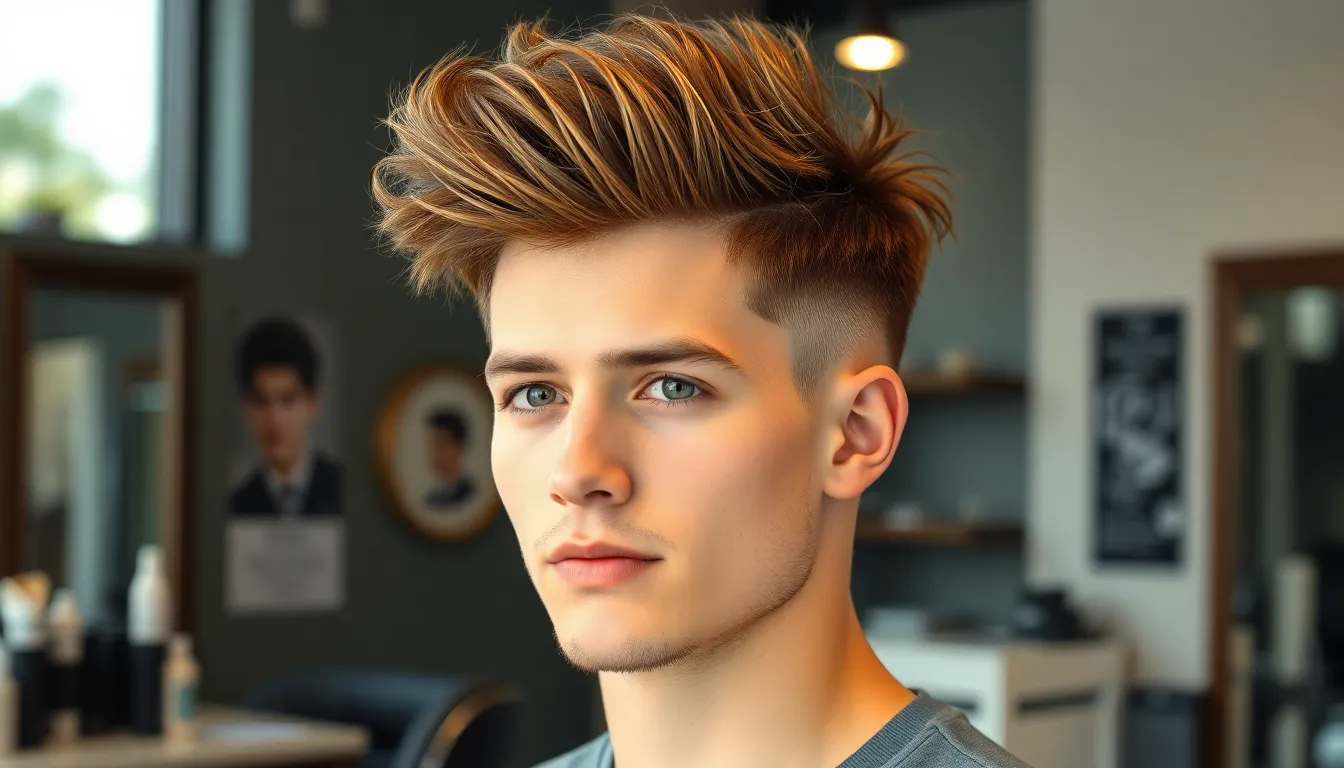
Creating textured fade combinations adds dimension and personality to traditional fade cuts. We’ll explore how exact styling techniques can transform standard fades into ever-changing, voluminous styles that work for various hair types.
Messy Top Fade Styles
Messy top fade styles combine the clean structure of precise sides with deliberately tousled crowns for modern appeal. Barbers achieve this look by maintaining 2-3 inches of length on top while creating seamless mid to high fade transitions on the sides. The key lies in using texturizing shears to remove bulk and create natural movement throughout the crown area.
Styling techniques for messy top fades include applying sea salt spray to damp hair and scrunching sections upward. We recommend using matte paste or clay products that provide hold without shine, allowing the natural texture to remain visible. Finger styling creates the most authentic messy appearance, avoiding combs or brushes that flatten the desired volume.
Maintenance schedules require touch-ups every 2-3 weeks to keep fade transitions sharp while allowing top length to develop natural texture. The contrast between structured sides and intentionally disheveled tops makes this style particularly effective for oval and diamond face shapes. Regular use of dry shampoo between washes helps maintain the textured, lived-in appearance that defines this contemporary look.
Wavy Hair Fade Techniques
Wavy hair fade techniques work with natural curl patterns to create enhanced volume and movement throughout textured styles. Barbers adapt their cutting approach by following the natural wave direction when establishing fade lines, ensuring seamless blends that complement rather than fight against natural growth patterns. The strategic placement of fade transitions at exact points along the wave cycle prevents awkward lines or disrupted curl formation.
Sectioning methods for wavy fades involve identifying natural part lines and wave crests before beginning clipper work. We focus on creating longer transition zones between fade levels to accommodate the natural volume that waves provide. This approach prevents the harsh contrasts that can occur when traditional fade techniques are applied to textured hair without consideration for natural patterns.
Product application becomes crucial for wavy fade success, with curl-defining creams applied to damp hair before air drying or diffusing. Leave-in conditioners help maintain moisture balance while reducing frizz that can disrupt the clean fade lines. The combination of properly executed fade techniques with wave-improving products creates styles that showcase both barbering precision and natural texture, resulting in cuts that appear effortlessly polished while maintaining authentic movement and volume.
Fade Cuts Specifically Designed for Different Face Shapes
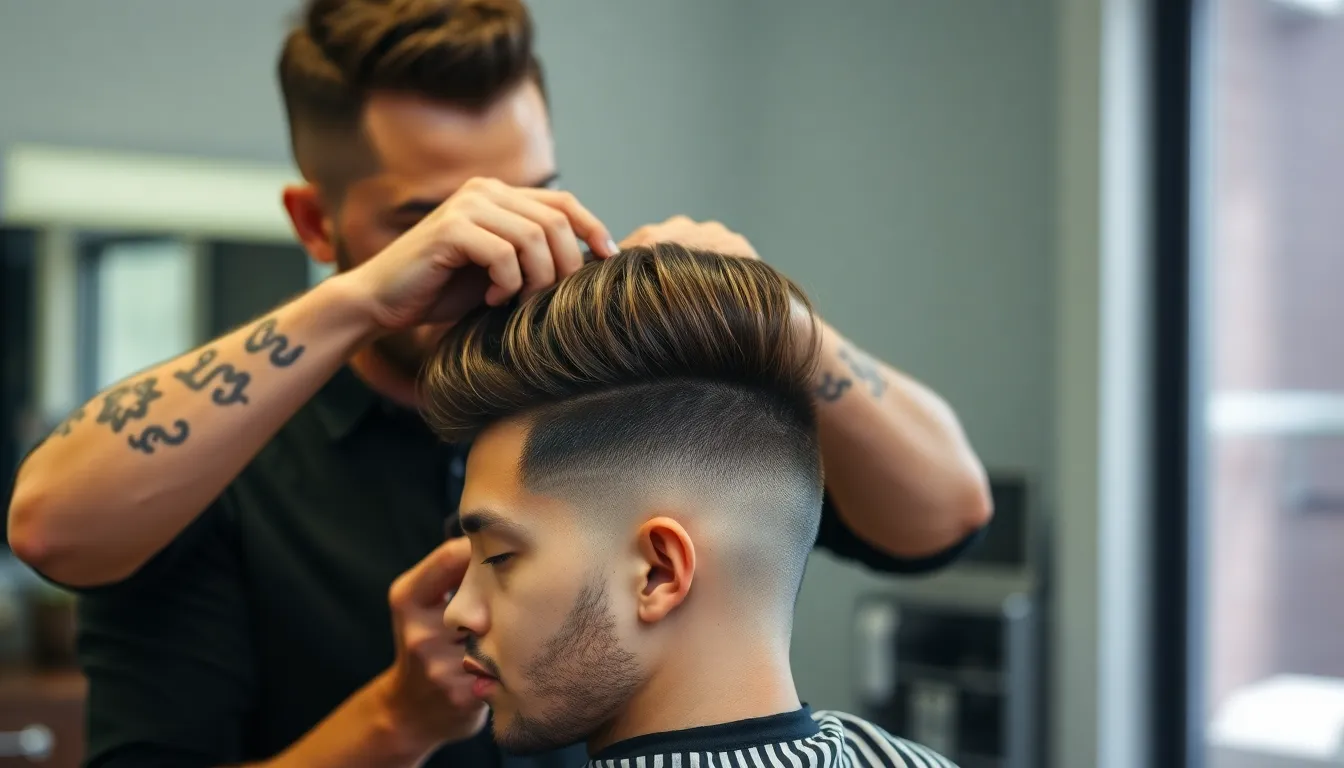
Selecting the right fade haircut depends largely on your facial structure and proportions. We recommend consulting with your barber to identify which fade variations will best complement your unique features.
Round Face Fade Recommendations
High fade cuts work exceptionally well for round faces by creating vertical lines that elongate your appearance. We suggest pairing high fades with voluminous top styles like pompadours or quiffs to add height and reduce the circular appearance of your face shape.
Avoid low fades if you have a round face since they can emphasize width and make your face appear fuller. Professional barbers typically recommend keeping the fade line above the temples to maintain the lengthening effect that high fades provide.
Side part combinations with mid to high fades create asymmetrical lines that break up roundness effectively. We often see clients with round faces benefit from textured tops that add vertical dimension while the fade provides clean, sharp contrast along the sides.
Maintain length on top when choosing your fade variation to maximize the elongating effect. Barbers frequently recommend at least 2-3 inches of hair on the crown area to create the vertical lines that flatter round facial structures.
Square Jaw Fade Adjustments
Soften angular jawlines with low to mid fade cuts that don’t create additional sharp contrasts around your face perimeter. We recommend gradual transitions that complement rather than compete with your naturally strong jaw structure.
Textured fade styles work particularly well for square faces by adding movement and reducing the geometric severity that high contrast fades might create. Professional stylists often suggest wavy or tousled top sections paired with subtle fade transitions.
Avoid skin fades or extremely high contrast cuts that can make square jaws appear more pronounced and harsh. We typically guide square faced clients toward fade styles that maintain some length around the temple area to create smoother transitions.
Consider beard integration when planning your fade cut since square faces often benefit from facial hair that connects seamlessly with the haircut. Barbers can blend your fade into beard lines to create cohesive, balanced proportions that enhance your natural jaw structure.
Maintenance Tips for Keeping Your Fade Fresh
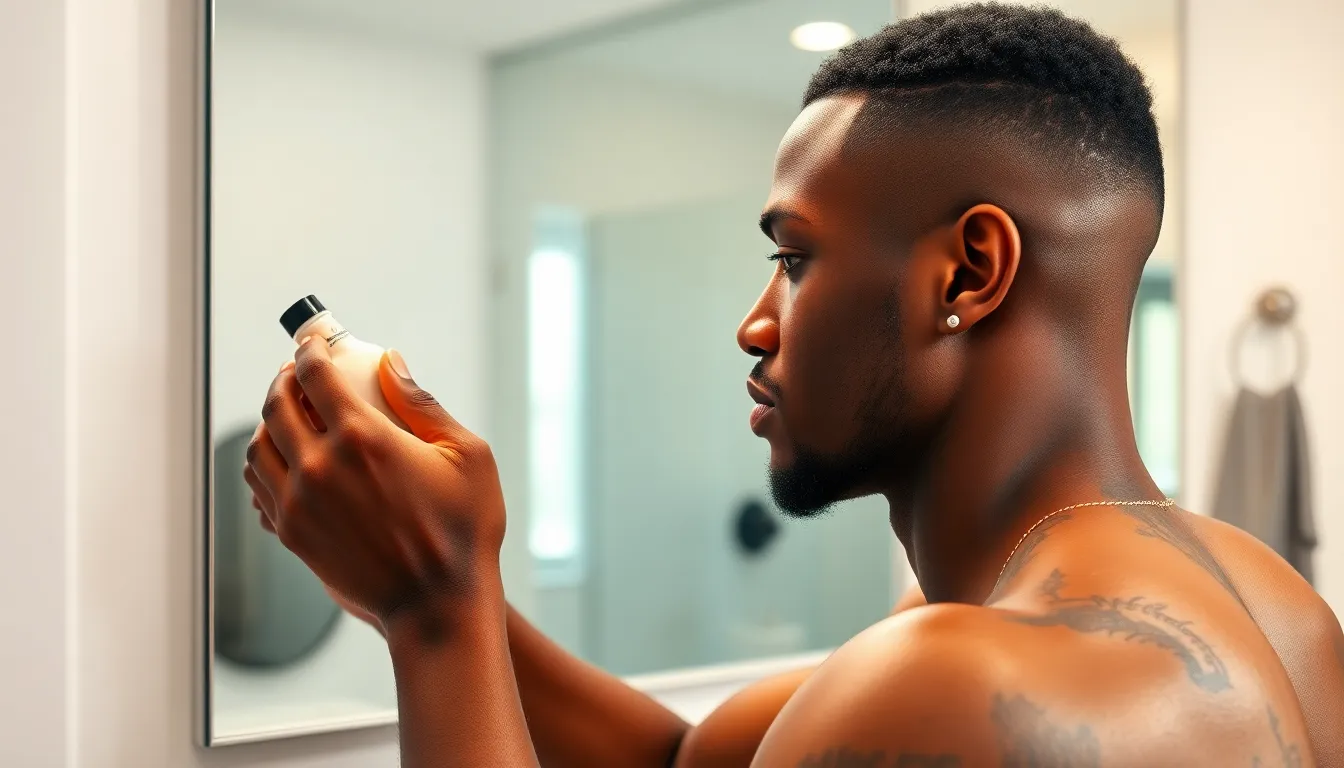
Maintaining your fade haircut requires consistent attention between barber visits to preserve its sharp appearance. We’ll explore effective scheduling and home care strategies that keep your fade looking professionally groomed.
Weekly Touch-Up Schedules
Scheduling professional touch-ups every 1-2 weeks maintains optimal fade appearance and prevents overgrowth. Most barbers recommend this frequency for high and mid fade cuts, as these styles show growth more prominently than low fades.
Business professionals with skin fades should book appointments weekly, since these cuts require the most precise maintenance. The sharp contrast between completely shaved areas and longer sections becomes less defined as hair grows back within 5-7 days.
Students and casual wear enthusiasts can extend their touch-up schedule to 10-14 days for low and mid fades. These styles maintain their structure longer due to less dramatic length transitions, making them more forgiving as hair grows.
Active individuals who exercise frequently may need weekly appointments regardless of fade type. Sweat and frequent washing can affect styling products and make hair appear uneven more quickly than normal.
Consider booking standing appointments with your barber to ensure consistent scheduling. We find that regular clients who maintain consistent schedules achieve better long-term results and develop stronger working relationships with their stylists.
Home Care Between Barber Visits
Washing your fade with quality shampoo 3-4 times per week prevents product buildup while maintaining healthy hair growth. Daily washing can strip natural oils and cause irritation to freshly shaved areas, particularly with skin fades.
Applying light styling products helps maintain shape without weighing down shorter sections of your fade. Pomades work best for slicked styles, while texturizing creams enhance natural movement in messy or wavy fade combinations.
Brushing or combing your fade daily distributes natural oils and keeps longer sections properly styled. Use a fine-tooth comb for precise parts and a boar bristle brush for textured styles that require volume.
Moisturizing shaved areas with aftershave balm or light moisturizer prevents irritation and ingrown hairs. This step becomes especially important for individuals with sensitive skin who maintain frequent skin fade touch-ups.
Trimming visible stray hairs with small scissors helps maintain clean lines between professional visits. Focus only on obviously overgrown areas around the ears and neckline, avoiding any cutting near the actual fade transitions.
Choosing the Right Fade Length for Your Lifestyle
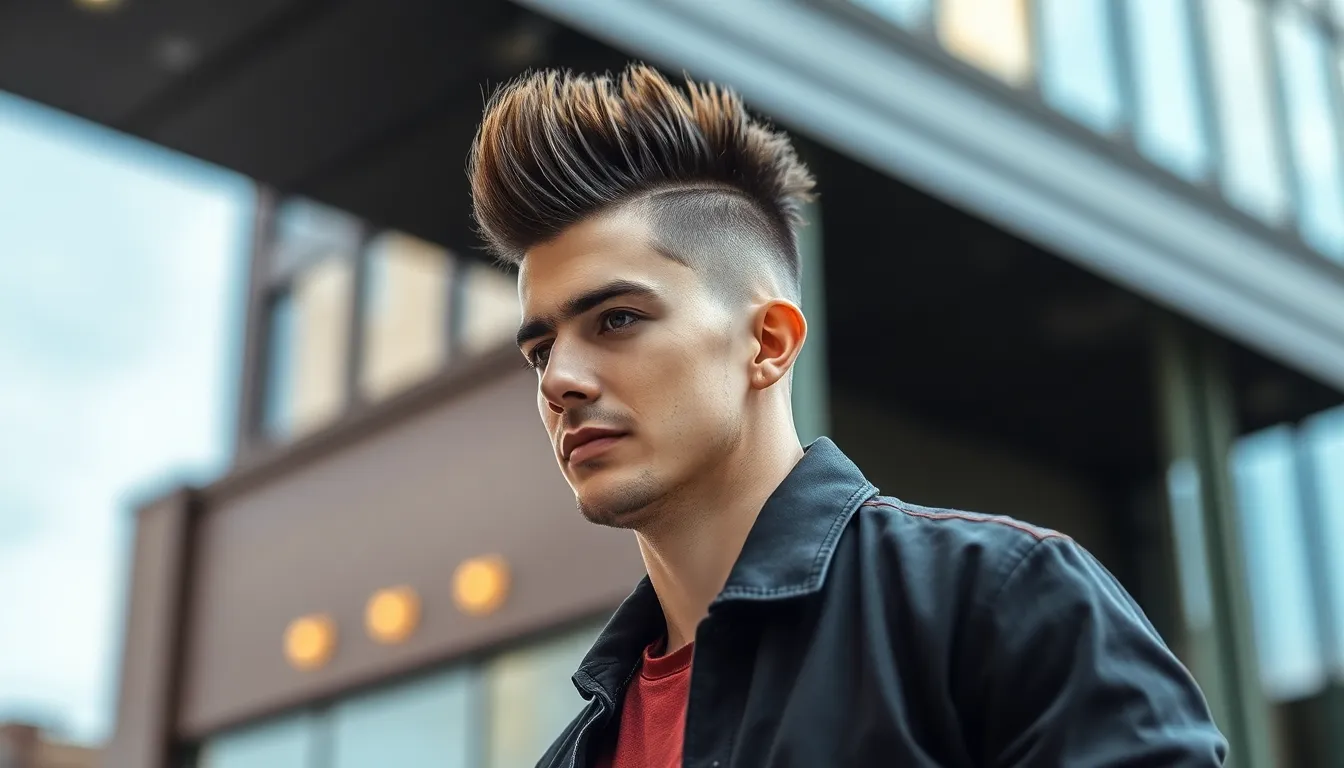
Selecting the perfect fade length depends on balancing your daily routine with personal grooming preferences. Your lifestyle demands will eventually determine which fade variation works best for your schedule and professional requirements.
Professional Environment Considerations
Corporate settings typically favor subtle fade variations that maintain polished appearances throughout long workdays. Low fade cuts blend seamlessly with business attire and require minimal daily styling, making them ideal for executives and professionals who need consistent grooming standards. Conservative industries like banking, law, and finance often prefer these understated approaches that complement formal dress codes.
Mid fade options work exceptionally well for creative professionals who need flexibility between casual and formal presentations. These cuts offer enough personality for client meetings while remaining professional enough for board presentations. Tech industry workers and consultants frequently choose mid fades because they balance modern appeal with workplace appropriateness.
High fade cuts suit professionals in ever-changing environments where personal expression aligns with company culture. Creative agencies, marketing firms, and startups often embrace these bold styles that reflect innovative thinking. Sales professionals sometimes prefer high fades because they create memorable first impressions while maintaining professional credibility.
Remote workers enjoy maximum flexibility in choosing any fade length since video calls typically show only partial views. Home based professionals can experiment with dramatic fade variations without worrying about daily office interactions.
Personal Style Preferences
Athletic individuals often gravitate toward skin fades and high cuts that complement active lifestyles and gym routines. These shorter styles require less maintenance during workouts and dry quickly after swimming or intense training sessions. Sports enthusiasts appreciate how high fades stay neat under helmets, caps, and headbands.
Fashion conscious men frequently choose mid to high fades that showcase their attention to contemporary trends. These cuts photograph well for social media and complement modern clothing styles from streetwear to designer fashion. Style influencers often rotate between different fade lengths to match seasonal trends and personal brand evolution.
Minimalist personalities typically prefer clean, simple fade variations that require minimal daily styling. Low fades appeal to men who value understated elegance over flashy statements. These individuals often choose classic cuts that remain timeless rather than following temporary trends.
Adventurous spirits experiment with dramatic fade contrasts and unique blending techniques that reflect their bold personalities. High skin fades and creative variations allow self expression while maintaining masculine appeal. These individuals often coordinate their fade choices with beard styles, tattoos, or other personal aesthetic elements.
Common Fade Mistakes to Avoid When Visiting Your Barber
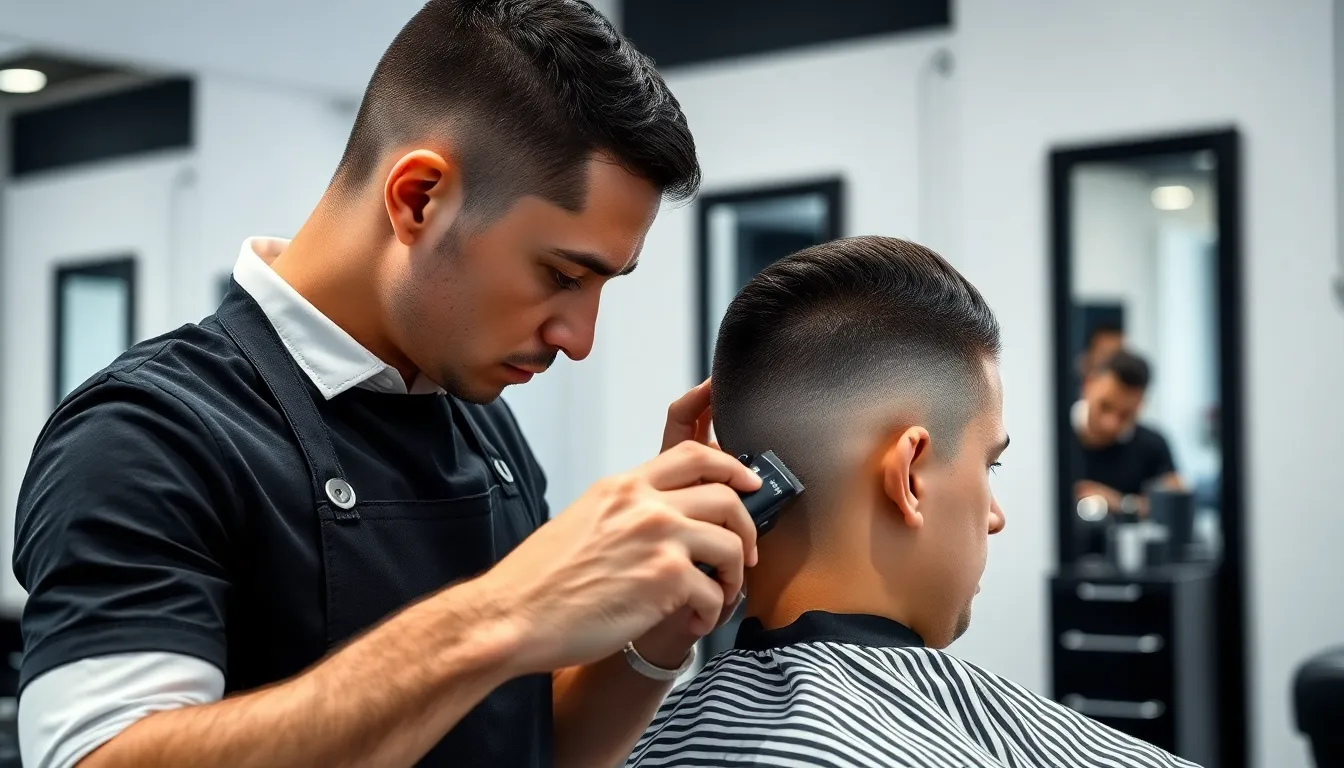
Getting the perfect fade requires more than just skilled barber hands. Avoiding these common pitfalls ensures you’ll walk out with exactly the style you envisioned.
Communication Tips for Better Results
Bring reference photos to eliminate guesswork during your consultation. We recommend saving multiple angles of your desired style on your phone to show your barber. Visual examples prevent miscommunication better than verbal descriptions alone.
Specify your fade height preference using clear measurements. Tell your barber whether you want a high fade starting 2-3 inches above your ears, a mid fade beginning at temple level, or a low fade starting just above your earline. These exact reference points ensure consistent results across different visits.
Discuss your lifestyle and maintenance commitment upfront. Let your barber know if you’re willing to visit weekly for touch-ups or prefer a style that grows out gracefully over 2-3 weeks. This information helps them adjust the fade intensity and length accordingly.
Ask questions about styling products and techniques during your appointment. We suggest requesting a quick demonstration of how to recreate your look at home. Most barbers appreciate clients who want to maintain their cuts properly between visits.
Schedule your next appointment before leaving the chair. Booking your follow-up visit ensures you’ll maintain your fade’s sharp appearance and builds a consistent relationship with your barber.
Red Flags to Watch For
Walk away if your barber doesn’t ask about your hair growth patterns before starting. Professional barbers assess cowlicks, natural part lines, and hair density to customize their cutting approach. Skipping this evaluation often leads to uneven fades that don’t complement your hair’s natural characteristics.
Notice if your barber uses only one clipper guard size throughout the fade process. Quality fade work requires multiple guards ranging from #0 to #4 to achieve smooth transitions. Single-guard cutting creates harsh lines instead of the gradual blend you’re paying for.
Stop the service if you see your barber rushing through the blending process. Proper fade blending takes time and requires careful attention to eliminate visible lines. Barbers who speed through this crucial step often leave you with choppy, uneven results.
Question any barber who doesn’t show you the back and sides in a mirror. We expect thorough quality checks from professional barbers who take pride in their work. Refusing to show you all angles suggests they’re not confident in their results.
Avoid barbers who can’t explain their technique or answer your questions. Knowledgeable professionals should be able to discuss their approach and offer maintenance advice. Evasive responses often indicate inexperience or lack of proper training.
Conclusion
Fade haircuts have proven themselves as timeless staples in men’s grooming that blend traditional barbering excellence with contemporary style demands. We’ve seen how these versatile cuts can transform any look while maintaining the professional polish that modern lifestyles require.
The key to fade success lies in understanding your unique needs – from face shape compatibility to lifestyle maintenance requirements. Whether you’re drawn to subtle low fades or bold high contrasts the right technique and proper care will keep your style sharp.
Remember that great fades are investments in your professional image that pay dividends through their adaptability and lasting appeal. With the right barber partnership and consistent maintenance schedule you’ll enjoy a polished appearance that works seamlessly across all aspects of your life.
Frequently Asked Questions
What is a fade haircut?
A fade haircut features gradual length transitions from longer hair on top to progressively shorter sides and back. Professional barbers use multiple clipper guard sizes and precise blending techniques to create seamless transitions without harsh lines. This versatile style ranges from subtle to dramatic variations, making it suitable for various face shapes and personal preferences while maintaining a polished, modern appearance.
How often should I get my fade haircut maintained?
High and mid fades typically require professional touch-ups every 1-2 weeks to maintain their sharp appearance. Low and mid fades can extend to 10-14 days for students and casual wearers. Active individuals may need weekly appointments regardless of fade type. Regular maintenance ensures clean lines and prevents the fade from growing out unevenly.
What’s the difference between high, mid, and low fade cuts?
High fades start the transition near the temples, creating dramatic contrast and vertical lines. Mid fades begin around the ear area, offering versatile balance for various lifestyles. Low fades start lower on the head near the neckline, providing subtle, professional appearances ideal for conservative environments. Each type suits different face shapes and style preferences.
Which fade haircut works best for my face shape?
Round faces benefit from high fade cuts that create vertical lines and elongate appearance. Square faces suit low to mid fade cuts that soften angular jawlines, with textured styles adding movement. Consult with experienced barbers to find the best fade variation that complements your individual features, including considerations for beard integration to enhance overall proportions.
What tools do barbers use to create perfect fade haircuts?
Professional barbers use high-quality clippers with multiple guard sizes, trimmer detailing tools for precise edges, texturizing shears for blending, and spray bottles for hair management. Advanced techniques may include razor work for ultra-precise results. Expert blending methods and systematic sectioning approaches ensure seamless transitions and eliminate harsh lines for polished finishes.
How do I maintain my fade haircut at home?
Wash hair with quality shampoo, use light styling products to avoid weighing down shorter sections, and brush daily to maintain shape. Moisturize shaved areas to prevent irritation and trim stray hairs to preserve clean lines between barber visits. Avoid heavy products that can create buildup and make the fade appear uneven or unkempt.
Can I get a fade if I have wavy or curly hair?
Yes, experienced barbers adapt cutting techniques to enhance natural curl patterns while creating seamless blends. They focus on preventing harsh contrasts between different hair lengths and textures. Proper product application helps maintain the fade’s structure while preserving natural movement and volume, creating effortlessly polished styles that work with your hair’s natural characteristics.
What should I tell my barber when requesting a fade?
Bring reference photos showing your desired fade height and style. Clearly specify whether you want high, mid, or low fade placement. Discuss your lifestyle, maintenance commitment, and professional environment requirements. Communicate your styling preferences and any concerns about face shape compatibility. Clear communication ensures your barber can tailor the cut to your specific needs and expectations.
Are fade haircuts suitable for professional environments?
Yes, fade haircuts are highly suitable for professional settings when chosen appropriately. Subtle low fades work perfectly in corporate environments, while mid fades offer flexibility for creative professionals. The key is selecting the right fade height and styling that aligns with your workplace dress code while maintaining a polished, well-groomed appearance.
What are common mistakes to avoid when getting a fade?
Avoid barbers who don’t assess your hair growth patterns or use only one clipper guard size. Don’t skip discussing lifestyle and maintenance commitments upfront. Avoid unclear communication about your preferences – always bring reference photos. Watch for red flags like rushed consultations or barbers who don’t explain their approach, as these can lead to uneven or unsatisfactory results.

